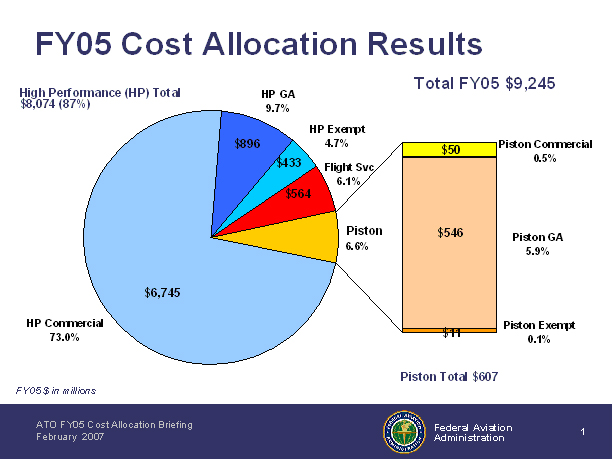Fact Sheet
For Immediate Release
February 14, 2007
Cost Allocation
The Federal Aviation Administration (FAA), working with PriceWaterhouseCoopers, has designed a simple, transparent, thorough, and repeatable cost allocation methodology.
The FAA used FY 2005 Cost Accounting System data – the most detailed and comprehensive cost data available as the proposal was being developed – to distinguish between two types of users:
- Turbine-powered aircraft (jets and turboprops) users drive most system costs because they fly in all weather, at all times of the day, tend to be time-sensitive, generally compete for the same air traffic control resources, and require complex air traffic equipment and procedures.
- Piston aircraft and helicopter users have different performance capabilities from high performance users in terms of speed and optimum altitude. These aircraft typically fly less complex equipment, tend to be less time sensitive, frequently fly under visual flight rules, and require different types of air traffic control resources.
The FAA allocated the costs of more than 600 Cost Accounting System projects between these two user types and determined that, in most cases, piston users were responsible for only a share of incremental costs. The total FY 2005 air traffic costs were allocated as follows:
- 87% to turbine users,
- 7% to piston users, and
- 6% to flight service stations (expected to decline in future years).
Within each group, the FAA divided costs among commercial, general aviation and public/tax exempt users based on their share of activity. In the terminal environment, the allocation looks at costs and activity within groups of similarly-sized airports. As a result, users of less costly facilities do not bear the costs of more expensive facilities.
This table summarizes the FY 2005 cost allocation results:
| Turbine | Piston | Flight Service | Total | |
|---|---|---|---|---|
| Commercial | 73.0% | 0.5% | n/a | 73.5% |
| General Aviation | 9.7% | 5.9% | n/a | 15.6% |
| Public/Exempt Users | 4.7% | 0.1% | n/a | 4.8% |
| Flight Service Stations | n/a | n/a | 6.1% | 6.1% |
| Subtotal | 87.3% | 6.6% | 6.1% | 100.0% |
Flight Service Station costs are not allocated among users because costs are expected to decline substantially in future years and the cost recovery proposal funds these costs from the General Fund.

